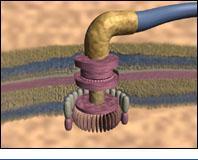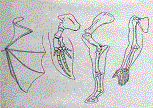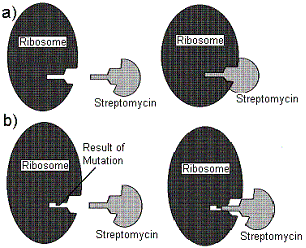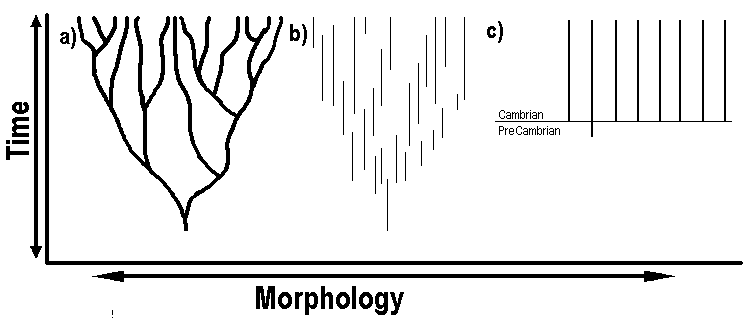Resources |
A brief qualitative discussion of evolutionary theory and its weaknesses
A. How does the theory of evolution work?

Charles Darwin hypothesized his theory of evolution in 1859 in The Origin of Species.
|
|
Random mutations cause changes, or variation, in a population of organisms.
These different organisms then compete to survive and reproduce.
Those which are best able to survive and reproduce do so, and tend to leave the most offspring. This is called "natural selection."
Over time, if some organisms survive and reproduce more than others, a species will "evolve."
What does Evolution Claim?
All organisms are related through "common ancestry."
All organisms arose through the process of mutation and natural selection.
All organisms arose and persist because of the random chance processes of nature.
The naturalistic story:

*Some reptiles are also said to have evolved into birds.
B. Common Criticisms of evolution:
1. The "Origin of Life"(not exactly the "evolution of life," but the chemical starting point of life)

This illustration shows a portion of an Escherichia coli cell, one of the “simplest” known bacteria. Many necessary parts are shown including the cell wall, flagellum, ribosomes, tRNA, mRNA, enzymes, and nucleus with DNA and its machinery. From http://www.scripps.edu/pub/goodsell/illustration/public
|
|
Life has never been created in a laboratory, contrary to popular belief.
If life is ever created in the lab, how would we know it could or would happen that way in the natural world?
Problems with the evolutionary "story" shown above:
- Some scientists and textbooks claim that amino acids, nucleotides and other "building blocks of life" (pre-biotics) were present on the early earth. However, the evidence does not seem to support this because although the famous "Miller Experiment" in 1953 did produce amino acids by sparking gasses, it did not use the gasses that geochemists think that were present in the earth’s atmosphere. When the correct gasses are used, no amino acids are created. There is also no geological evidence that there was a "primordial soup," but even if it "soup" did exist, it would quickly have been destroyed by UV light, or quickly degrade through a chemical reaction similar to "browning" on an apple.
- Some propose that life or the "building blocks" came to earth from outer space. Most studies of this hypothesis have shown that all organic material would be superheated and destroyed upon entering the atmosphere and impact.
- Even if the ‘building blocks" of life were present in a soup, there is no known natural chemical process for how they would naturally and spontaneously form more complex molecules such as polymers, proteins, RNA, or DNA.
- There is a "Chicken and Egg" problem: DNA needs enzymes and proteins to replicate, but enzymes and proteins are created by DNA. DNA-enzyme package must stay together--DNA must create a "cell membrane". DNA, proteins, and the cell membrane must all be present at once for life to exist.
- Life is "exceedingly complex" and far too complex to arise naturally! The simplest bacterial cell has hundreds of genes:
"[T]he most elementary type of cell constitutes a 'mechanism' unimaginably more complex than any machine yet thought up, let alone constructed, by man." (W. H. Thorpe)
There is no way that an entire cell could come into being all at once. As for getting the first cell, there is much cellular "machinery" that is linked in "irreducibly complex" ways. Even simple organisms could not arise naturally. [See Footnote 1]
Recommended References: The Mystery of Life's Origin by Charles Thaxton, Walter Bradley, and Roger Olsen OR "Problems with the Origins of Life" on the IDEA Center website at "http://www.ideacenter.org/origlife.htm".
2. Irreducible Complexity:

Some of the “simplest” bacterial cells contain this “bacterial flagellum,” which functions like an outboard motor for swimming bacteria. Many scientists believe this organ is irreducibly complex. From:
http://www.arn.org/docs/mm/motor.htm
|
|
In The Origin of Species, Charles Darwin said:
"If it could be demonstrated that any complex organ existed which could not possibly have been formed by numerous, successive, slight modifications, my theory would absolutely break down."
There are many biological parts which function like "machines." These machines only work if all the parts are present (for an example, see the Bacterial Flagellum). If one part is removed, the entire machine "breaks down." The word "irreducible" means: "Impossible to reduce to a desired, simpler, or smaller form." Such machines are "irreducibly complex," because if they had any fewer parts, they would not work properly. Evolution cannot build irreducibly complex organs because evolution requires that all things arise in small steps, each of which are functional. For irreducibly complex organs, small steps are impossible because the organ is only functional if all parts are present. In this "all or nothing" game, "intermediate stages" of evolution are impossible because they would not function. Irreducibly complex biological features thus cannot be built in a "step-by-step" evolutionary manner. As evolutionist Robert Carroll asks, "How can we explain the gradual evolution of entirely new structures, like the wings of bats, birds, and butterflies, when the function of a partially evolved wing is almost impossible to conceive?"
Recommended References: Darwin's Black Box, by Michael Behe or "Irreducible Complexity: The Challenge to the Darwinian Evolutionary Explanations."
3. Genetic Evidence:
Evolutionists believe that all life forms are interrelated. This is called "common ancestry" or "common descent." This hypothesis can be tested by constructing hypothetical "family trees" (called "phylogenetic trees") based off of assuming common descent, and then comparing the similarities of various characteristics of organisms such as genes and DNA sequences. If common descent were true, the trees would show neat lines of ancestry and inheritance of biological characteristics. Often, these do not form a "tree," as demonstrated in the "bush" or "thicket" at left. This "bush" phenomenon is true for various types of organisms, as one evolutionist said, "the wealth of competing … proposals [of] the prevailing phylogenies of the mammalian orders would reduce [the mammalian tree] to an unresolved bush..." The basic problem is that when evolutionists compare different characteristics, they often get different trees. Furthermore, it is assumed that similarities are the result of common descent and not "common design" (compare limbs of mammals above as evidence for "common design"). These assumptions and discrepancies show that evidence for common ancestry is weak.

The base of the "tree of life" is not "treelike" at all, but rather forms a tangled thicket or a "bush". Figure from Doolittle (1999). |

Couldn’t these similarities in vertebrate limbs be the result of "common design" rather than "common descent"? (Drawing from Icons of Evolution)
|
Recommended Reference: Icons of Evolution, by Jonathan Wells and Evolution: A Theory in Crisis by Michael Denton or visit the IDEA Center website at "http://www.ideacenter.org/falsify.htm".
4. Limitations of Chance Mutations:
Evolutionary theory claims that random mutations can build very complicated biological structures over time. Yet, mutations are almost always harmful to the organism, as Nobel Prize winner H.J. Muller admits, "[i]t is entirely in line with the accidental nature of natural mutations that extensive tests have agreed in showing the vast majority of them to be detrimental to the organisms in its job of surviving and reproducing, just as changes accidentally introduced into any artificial mechanism are predominantly harmful to its useful operation." French evolutionist Pierre-Paul Grasse noted that, "No matter how numerous they may be, mutations do not produce any kind of evolution." One oft-cited example of a "beneficial" mutation is antibiotic resistance in bacteria. Yet antibiotic resistance usually involves the addition and origin of no new information into the genome. Below, a simple point mutation in the ribosome prevents the drug streptomycin from attaching, granting resistance. This is microevolution because it involves only minor change "within a species" and does not add new information. Antibiotic resistance is different from macroevolution and does not explain how new biological structures arise.
 Antibiotic resistance usually involves the origin of no new information into the genome. In part a, streptomycin, an antibiotic drug, attaches to a matching site on bacterial ribosomes to interfere with protein synthesis. In part b, a mutation in the matching site of the ribosome prevents the streptomycin molecule from attaching, making the bacterial cell resistance to the streptomycin. This simple point mutation causes only a minor structural change and does not explain how new complex biological structures can arise. Antibiotic resistance does not provide support for macroevolution. From Not by Chance! By Lee Spetner. Antibiotic resistance usually involves the origin of no new information into the genome. In part a, streptomycin, an antibiotic drug, attaches to a matching site on bacterial ribosomes to interfere with protein synthesis. In part b, a mutation in the matching site of the ribosome prevents the streptomycin molecule from attaching, making the bacterial cell resistance to the streptomycin. This simple point mutation causes only a minor structural change and does not explain how new complex biological structures can arise. Antibiotic resistance does not provide support for macroevolution. From Not by Chance! By Lee Spetner.
|
Recommended References: Not by Chance! by Lee Spetner, Darwin's Black Box by Michael Behe and No Free Lunch by William Dembski. See also http//www.ideacenter.org/nonfuncint.htm.
5. Developmental Evidence:
Many who take evolution in school may hear the phrase, "ontogeny recapitulates phylogeny," meaning that evolutionary history is supposedly reflected during the growth and development of an organism. Commonly cited evidence is the alleged presence of fish gills in human embryos during growth (which are NOT true gills but rather are merely small wrinkles in the neck that appear during development). These ideas were put forth by 19th century embryologist Ernst Haeckel, who today is known to have fabricated and exaggerated his data. Accurate comparisons of embryos of humans, fish, chickens, and amphibians show they begin very different, briefly become somewhat similar at an intermediate stage, and then end different. If "ontogeny recapitulates phylogeny" and these organisms share a common ancestry, these embryos should be similar from the very beginning and grow more different during development. Because they start different, patterns of animal growth and development are at odds with predictions of evolution. Compare the embryos at left (illustrations taken from Icons of Evolution by Jonathan Wells).
Recommended Reference: Drawings below are from Icons of Evolution, by Jonathan Wells (Regnery, 2000).
6. Fossil Evidence:
Evolution predicts that there will be fossils showing how one form turned into another form over millions and millions of years. These "missing links," however, are not found for the vast majority of the time. Charles Darwin said:
"...The number of intermediate varieties, which have formerly existed on the earth, [must] be truly enormous. Why then is not every geological formation and every stratum full of such intermediate links? Geology assuredly does not reveal any such finely graduated organic chain; and this, perhaps, is the most obvious and gravest objection which can be urged against my theory." (Darwin, The Origin of Species)
Out of tens of thousands of species known from the fossil record, only a few are claimed to be Darwin's missing "transitional forms." However, a close analysis of these few fossils (commonly cited ones are Archaeopteryx [a bird], Ambulocetus [a land mammal], and Acanthostega [an amphibian]) reveal that they do not shed any light on the origin of the important features of their respective groups and are often incomplete. Famous paleontologist Stephen Jay Gould said,
"The absence of fossil evidence for intermediary stages between major transitions in organic design, indeed our inability, even in our imagination, to construct functional intermediates in many cases, has been a persistent and nagging problem for gradualistic accounts of evolution." (Gould, Paleobiology, vol 6(1), p. 127)
Dr. Gould proposed a theory called "Punctuated Equilibrium" which is meant to account for the lack of transitional forms, saying we don’t find transitional forms because transitions did not have a chance to be fossilized. But punctuated equilibrium does not fit with the workings of genetics--too much biological complexity must be built with far too few rolls of the dice. The lack of transitional forms remains unaccounted for and is strong evidence against evolution.

Darwin’s theory (a) predicts that fossil transitions between different types of organisms will be found. When transitions were not found, evolutionists proposed punctuated equilibrium (b), where the transitional forms existed briefly, and were not fossilized. Model (C) represents the fossil record with regards to the origin of the phyla. The sudden appearance of organisms points to design, not evolution.
|
Recommended References: Darwin on Trial by Phillip Johnson, Evolution: The Fossils Still Say No! by Duane Gish, Evolution: A Theory in Crisis by Michael Denton, Bones of Contention by Marvin L. Lubenow, Refuting Evolution by Jonathan Sarfati, or see the IDEA Center website Fossil Record page at "http://www.ideacenter.org/fossrec.htm".
-------------------
Footnotes:
Footnote 1:
There has occasionally been confusion about this part of our website as to whether or not evolutionists are claiming that the cell must have arisen "all at once." Evolutionists indeed do not claim that the cell arose "all at once," because Darwin's theory requires that things evolve via "numerous, successive, slight modifications." (Darwin, Origin of Species) However, the cell requires a large number of parts in order for it to function. This is particularly true with regards to the workings of DNA and its replication enzymes and protein-creation mechanisms. All of these parts must be present or the cell would not function. Thus, it is precisely because evolution cannot produce complex features "all at once" that evolution fails as an explanation for the origin of the first cell. Please see The DNA - Enzyme System is Irreducibly Complex for a more detailed explanation.
|

